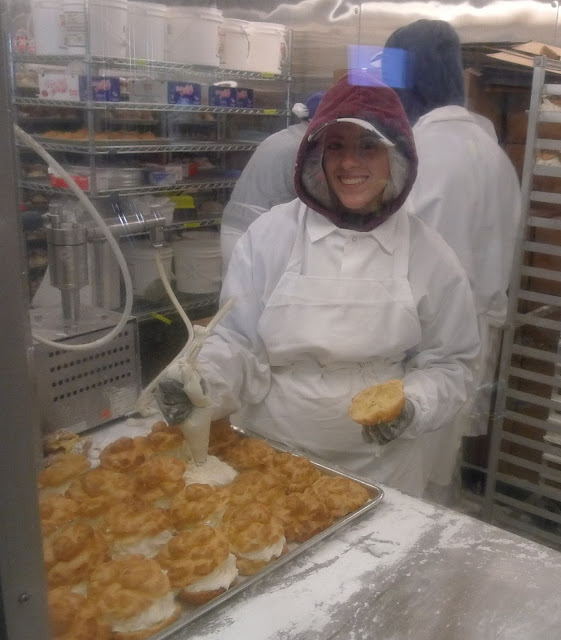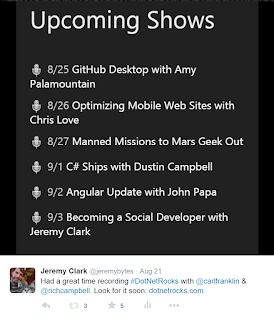I spent two weeks on the road in August, speaking at both the Quicken Loans Technology Conference (in Detroit, MI) and That Conference (in Wisconsin Dells, WI). Since I haven't spent time in that part of the country before, I took some time for sight-seeing as well.
Nothing code related this time; just a few pictures of my time on the road.
Day 1 - Flying Out
With time changes and flight times, it takes a while to travel from Southern California to Detroit. The entertainment started at John Wayne Airport where I saw two planes staring each other down.
 |
| Who will win? |
Day 2 - Detroit
I had a day to sight-see in Detroit. This is not the blighted city that we often hear about in the media. The downtown area has been going through an amazing transformation over the last 5 years. Abandoned buildings are being renovated, and improvements to public spaces invite people to spend time downtown.
 |
| Detroit |
Detroit has a view of Canada. It's just across the river.
 |
| Windsor, ON - Canada |
Later that night, I attended a dinner for the Quicken Loans Technology Conference. Lots of good conversations with some folks I haven't seen for a while, plus good conversations with people I met for the first time.
 |
| Dinner |
Day 3 - Quicken Loans Technology Conference
The next day was the Quicken Loans Technology Conference. There were lots of interesting speakers, including keynotes by Dan Morales, CIO of eBay and Richard Campbell & Carl Franklin of .NET Rocks.
I had a great time speaking about Clean Code (as I usually do).
 |
| Jeremy Talks "Clean Code" |
I met a lot of great people at Quicken Loans and got to see first-hand all of the good things that I've heard about the company.
Day 4 - Henry Ford Museum
I had decided to rent a car and drive from Detroit to Wisconsin Dells (it's only about 400 miles -- I'm driving that far this week just to get to the Bay Area in California).
Along the way, I stopped at the Henry Ford Museum in Dearborn, MI. What an incredible place. If you like mechanical things, this is the place to be. I was amazed by things that seem simple now but were a great innovation at the time. For example, here's a hay mower:
 |
| Hay Mower |
The blades look like a modern hedge trimmer (with an oscillating blade moving over a stationary one). But it was geared into the wheel, so the blade would move as the wheel turned. Really cool stuff.
Plus, planes, trains, automobiles, tractors, plus the Dymaxion House by Buckmeister Fuller. If you're ever in the area, you need to stop by.
Day 5 - Indiana
The next day was mainly travel. I drove across Michigan and into Indiana. It was beautiful and green along the way.
 |
| Welcome to Indiana |
Day 6 - Wisconsin
The next day was more travel. I drove by Chicago, IL and Milwaukee, WI. It was great to see the skylines of the cities (and I was looking forward to going back to Chicago the following week).
At a rest stop in Wisconsin, I saw that they take their recycling really seriously.
 |
| Recycling |
Day 7 - Madison
I stayed in Madison,WI and went to the Henry Vila Zoo. It's a free zoo that has quite a selection of animals. I spent quite a bit of time with the goats (someday, I'll have goats of my own):
 |
| GOAT! |
I've always loved goats, and they seem to like me as well. They would run over to folks who had food to give them. But once the food was gone, they would come back to me for scratches.
Then I drove on to the Kalahari Resort in Wisconsin Dells -- the location of That Conference. I spent about an hour in the registration line that night. It sounds like a long time, but it gave me a chance to talk to 10 new people. If you want to hear more about that, be sure to tune in to
.NET Rocks! on September 3rd, where I'll be talking about
becoming a social developer (or check out this recent
article about That Conference).
Day 8 - That Conference
That Conference was a really great event. I met tons of great people and saw a lot of great tech.
Day 9 - That Conference
There were tons of great sessions, and a few pearls of wisdom. Here's one from Stephen Cleary in reference to asynchronous programming:
 |
| Every Time You Use Async Void, Rory Dies |
And here's something from David Neal that we should never forget:
 |
| You Don't Need Permission to be Awesome |
Later that night, there was a party at the water slide park at the resort. I think I figured that I hadn't been on a water slide for over 20 years, but I didn't let that stop me. I went on pretty much everything, including the 4-story, straight down slide. I had chlorine in my sinuses for the next 2 days. But it was totally worth it.
Day 10 - That Conference
The last day of That Conference, I was mostly on the hallway track -- speaking to folks I had met during the week, and hosting an open spaces session with Ondrej Balas on building your brand as a developer.
I finally got to speak on the last day of That Conference. In fact, I presented during the last breakout session of the conference.
 |
| Jeremy Talks "Clean Code" (again) |
Thanks to all the people who came. We had a great time together. Here are a few tweets from that afternoon:
There's a lot more that I could say about That Conference, but we'll save that for another day. I met a ton of great people, got to catch up with a few old friends, and had some really amazing conversations. I'll look forward to going again next year.
Day 11 - Circus World
After That Conference wrapped up, I had a few days to make my way back to Chicago where I would be flying out.
I spent a day at Circus World in Baraboo, WI. This was the winter home for the Ringling Bros Circus, and the site dates back to the early 1900s.
 |
| Novelty Musical Intruments |
I got to see the novelty musical instrument show, which included this interesting contraption. The cranks were attached to hammers that struck a xylophone-type tuned bar. In addition, there was a big top show with unicyclists, clowns, performing dogs, camels, elephants, and aerialists.
Later that day, I went to the Timbavati Wildlife Park, where I got to pet a kangaroo:
 |
| Kangaroo |
And I went to the races as well:
 |
| Pig Races |
Day 12 - Wisconsin State Fair
The next day, I spent the day at the Wisconsin State Fair (just outside Milwaukee). I was especially happy to be there since I was missing the Orange County Fair back home.
 |
| Wisconsin Cows |
This was much different from my local fair. For example, at the Orange County Fair, most of the animals are 4-H or FFA projects. The Wisconsin State Fair had tons of animals from working farms. There were 2 cow barns, a 2-story horse barn, a sheep barn, a goat barn, and a bunny and chicken barn, plus a big covered arena (which was nice since it was hot and sunny out).
While in the arena watching a horse competition, I heard someone say, "I'm more of a cow person. I would buy a cow if I could afford one." Not something I'm used to hearing.
There was also a Cream Puff building where they were making tons of fresh cream puffs (and selling them just as fast as they made them).
 |
| Cream Puffs being made |
Really tasty. Lots of other great stuff to eat, too.
Day 13 - Little Amerricka
The next day, I found myself in Marshall, WI at the Little Amerricka amusement park. This was an awesome little place between the corn fields and the cemetery. Lots of rides and lots of fun. The Mad Mouse was a historic little ride that is a lot more terrifying than it looks.
 |
| Mad Mouse at Little Amerricka |
This is one of those rides that was made before lawyers existed. You just get in the little sled with wheels and hang on -- no lap bars or seat belts.
In addition, a great wooden roller coaster, a toboggan ride, a "monorail", ferris wheel, bumper boats, haunted house, mini golf, and lots more. I had a really great time. And I was hot and exhausted by the time I was done. A great place to visit.
Day 14 - The Field Museum
My last day was in Chicago, IL. Rather than trying to park in the city, I decided to take the "L" in.
 |
| The "L" |
This was a great system to use. It was easy, the trains and stations were well marked, there was good air conditioning, and the station announcements made it easy to know where to get off. As an aside, I always thought the Chicago train was referred to as the "el" -- short for "elevated train" -- I stand corrected.
This was also a great way to see the city. There were good views from the elevated track, and I got to see a variety of neighborhoods (at least until it went underground near the "Loop").
The goal was The Field Museum. I've wanted to go there for many years for one reason: to see Sue the T-Rex. And I was very excited when I finally saw her:
 |
| Jeremy and Sue |
This journey started many years ago when I first heard about Sue on television. Then a bit later, I visited the Black Hills Institute in South Dakota (the folks who found Sue). Then I got to see a replica of Sue in Orlando, FL a few years after that. I was excited to reach the end of the journey.
There was lots of other cool stuff at The Field Museum. This little picture really made me laugh, though:
 |
| Oxygen |
This is showing how photosynthesis in early cells resulted in the oxygen in the atmosphere. I got a chuckle out of the cell farting out oxygen like "What are you gonna do?".
Out one of the windows, I got a good picture of the Chicago skyline.
 |
| Chicago, IL |
Day 15 - HOME
I ran myself pretty ragged during these two weeks. So, I was really glad to be headed back home. I didn't get to do an architectural tour of Chicago (there are tons of really cool skyscrapers), but I'm sure I'll have plenty of other opportunities to go to Chicago. And I bought a "Pocket Guide to Chicago Architecture" at the airport. So I have a good reason to go back.
I'll get back to the technical articles soon. Plus, my YouTube channel just passed 1,000 subscribers, so I'd better produce a new video soon. Until then...
Happy Coding!















































